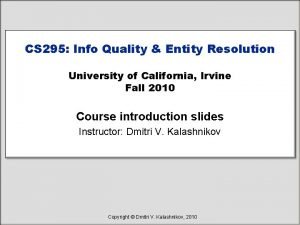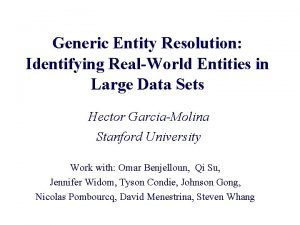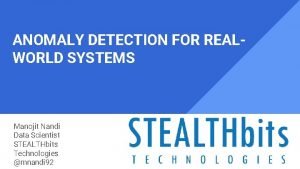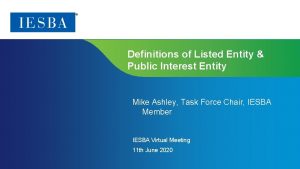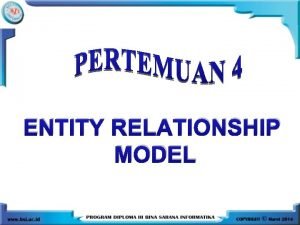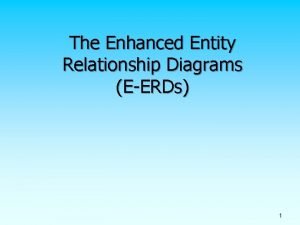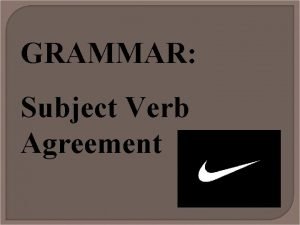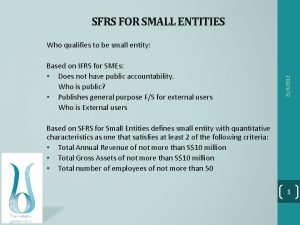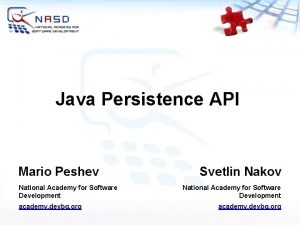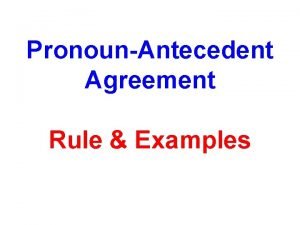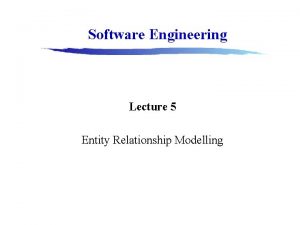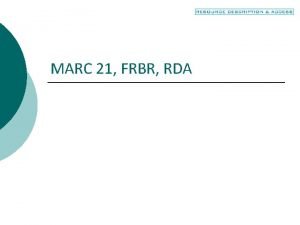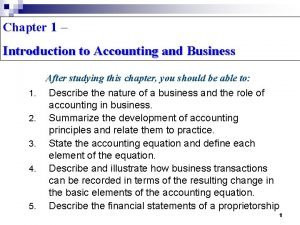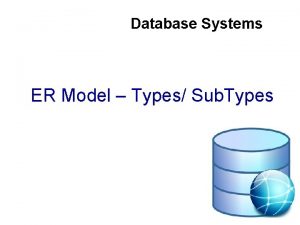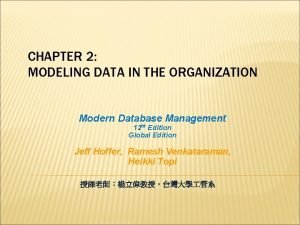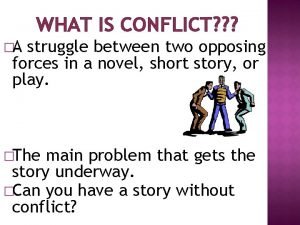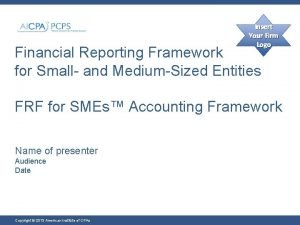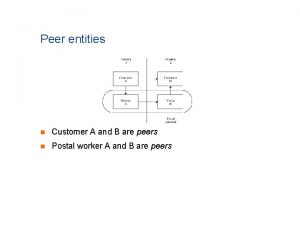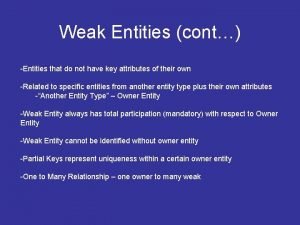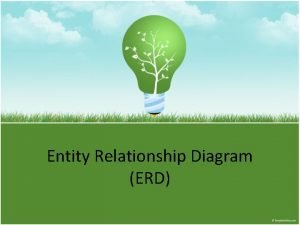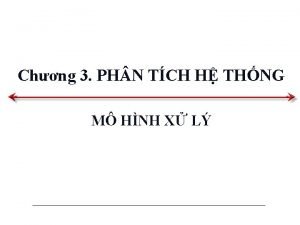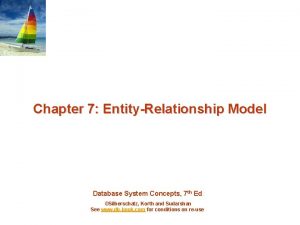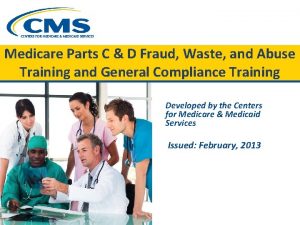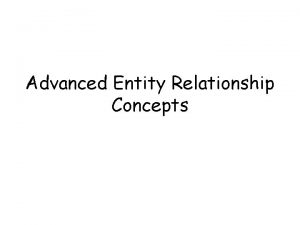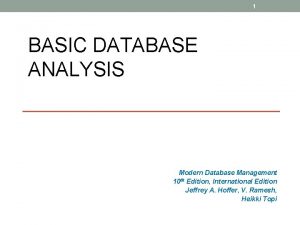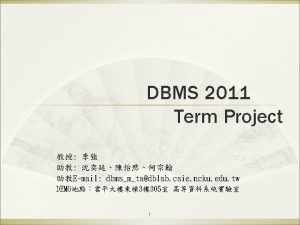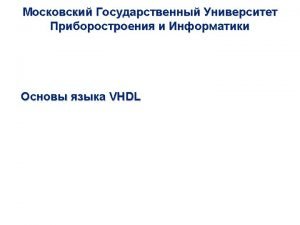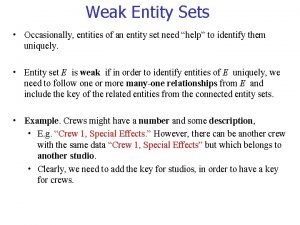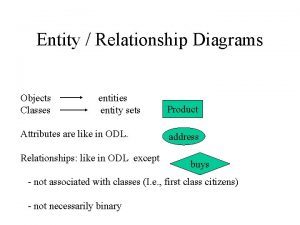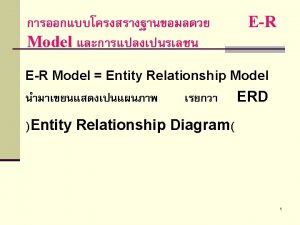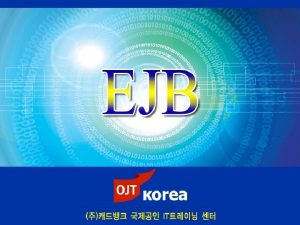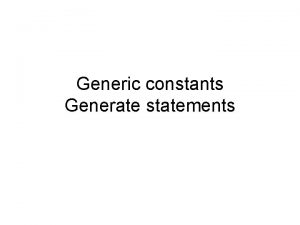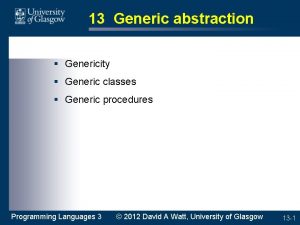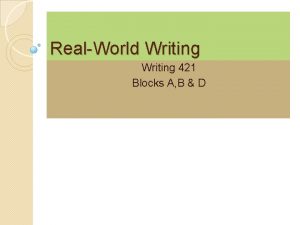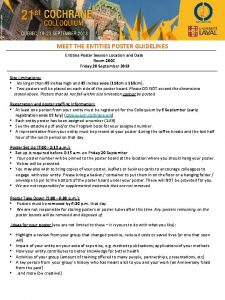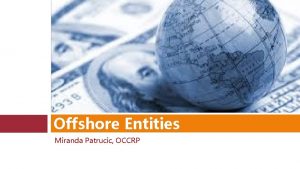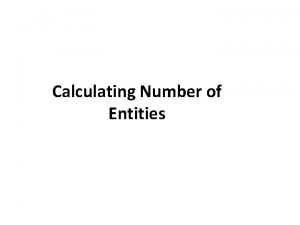Generic Entity Resolution Identifying RealWorld Entities in Large
























![Brute Force Algorithm • Input R: – r 1 = [a: 1, b: 2] Brute Force Algorithm • Input R: – r 1 = [a: 1, b: 2]](https://slidetodoc.com/presentation_image/14c1f01fafa382da541a93152bcb9c97/image-25.jpg)



















- Slides: 44

Generic Entity Resolution: Identifying Real-World Entities in Large Data Sets Hector Garcia-Molina Stanford University Work with: Omar Benjelloun, Qi Su, Jennifer Widom, Tyson Condie, Johnson Gong, Nicolas Pombourcq, David Menestrina, Steven Whang

Entity Resolution e 2 e 1 N: a A: b CC#: c Ph: e N: a Exp: d Ph: e 2

Applications • comparison shopping e 1 • mailing lists • classified ads N: a A: b • customer files CC#: c Ph: e e 2 • counter-terrorism N: a Exp: d Ph: e 3

Outline • Why is ER challenging? • How is ER done? • Some ER work at Stanford • Confidences 4

Challenges (1) • No keys! • Value matching – “Kaddafi”, “Qaddafi”, “Kaddaffi”. . . • Record matching Nm: Tom Ad: 123 Main St Ph: (650) 555 -1212 Ph: (650) 777 -7777 Nm: Thomas Ad: 132 Main St Ph: (650) 555 -1212 5

Challenges (2) • Merging records Nm: Tom Ad: 123 Main St Ph: (650) 555 -1212 Ph: (650) 777 -7777 Nm: Thomas Ad: 132 Main St Ph: (650) 555 -1212 Zp: 94305 Nm: Tom Nm: Thomas Ad: 123 Main St Ph: (650) 555 -1212 Ph: (650) 777 -7777 Zp: 94305 6

Challenges (3) • Chaining Nm: Tom Ad: 123 Main BD: Jan 1, 85 Wk: IBM Oc: lawyer Nm: Thomas Ad: 123 Maim Oc: lawyer Nm: Tom Wk: IBM Oc: laywer Sal: 500 K Nm: Tom Ad: 123 Main BD: Jan 1, 85 Wk: IBM Oc: lawyer Sal: 500 K 7

Challenges (4) • Un-merging Nm: Tom Ad: 123 Main BD: Jan 1, 85 Wk: IBM Oc: lawyer Sal: 500 K too young to make 500 K at IBM!! 8

Challenges (5) • Confidences in data (0. 8) Nm: Tom (0. 9) Ad: 123 Main St (1. 0) Ph: (650) 555 -1212 (0. 6) Ph: (650) 777 -7777 (0. 8) • In value matching, match rules, merge: conf = ? 9

Taxonomy • Pairwise snaps vs. clustering • De-duplication vs. fidelity enhancement • Schema differences • Relationships • Exact vs. approximate • Generic vs application specific • Confidences 10

Schema Differences Name: Tom Address: 123 Main St Ph: (650) 555 -1212 Ph: (650) 777 -7777 First. Name: Tom Street. Name: Main St Street. Number: 123 Tel: (650) 777 -7777 11

Pair-Wise Snaps vs. Clustering r 1 r 2 s 7 r 5 r 2 s 9 r 3 r 4 r 1 r 8 s 10 s 8 r 7 r 3 r 9 r 10 r 4 r 5 r 6 12

De-Duplication vs. Fidelity Enhancement B R S S N 13

Relationships r 2 r 1 father r 7 brother business r 5 14

Using Relationships authors same? ? papers a 1 p 1 a 2 p 2 a 3 p 5 a 4 p 7 a 5 15

Exact vs Approximate ER cameras CDs ER resolved cameras ER resolved CDs ER resolved books products books . . . 16

Exact vs Approximate ER terrorists sort by age terrorists Widom 30 match against ages 25 -35 17

Generic vs Application Specific • Match function M(r, s) • Merge function <r, s> => t 18

Taxonomy • Pairwise snaps vs. clustering • De-duplication vs. fidelity enhancement • Schema differences • Relationships • Exact vs. approximate • Generic vs application specific • Confidences 19

Outline • Why is ER challenging? • How is ER done? • Some ER work at Stanford • Confidences 20

Taxonomy • Pairwise snaps vs. clustering • De-duplication vs. fidelity enhancement • Schema differences No • Relationships No • Exact vs. approximate • Generic vs application specific • Confidences. . . later on 21

Model r 1 Nm: Tom r 2 Ad: 123 Main BD: Jan 1, 85 Wk: IBM Nm: Thomas Ad: 123 Maim Oc: lawyer M(r 1, r 2) Nm: Tom Ad: 123 Main BD: Jan 1, 85 Wk: IBM Oc: lawyer r 4: <r 1, r 2> r 3 Nm: Tom Wk: IBM Oc: laywer Sal: 500 K M(r 4, r 3) Nm: Tom Ad: 123 Main BD: Jan 1, 85 Wk: IBM Oc: lawyer Sal: 500 K <r 4, r 3> 22

Correct Answer r 1 r 2 s 7 s 9 r 3 r 4 ER(R) = All derivable records. . . s 10 Minus “dominated” records s 8 r 5 r 6 23

Question • What is best sequence of match, merge calls that give us right answer? 24
![Brute Force Algorithm Input R r 1 a 1 b 2 Brute Force Algorithm • Input R: – r 1 = [a: 1, b: 2]](https://slidetodoc.com/presentation_image/14c1f01fafa382da541a93152bcb9c97/image-25.jpg)
Brute Force Algorithm • Input R: – r 1 = [a: 1, b: 2] – r 2 = [a: 1, c: 4, e: 5] – r 3 = [b: 2, c: 4, f: 6] – r 4 = [a: 7, e: 5, f: 6] 25

Brute Force Algorithm • Input R: • Match all pairs: – r 1 = [a: 1, b: 2] – r 2 = [a: 1, c: 4, e: 5] – r 3 = [b: 2, c: 4, f: 6] – r 4 = [a: 7, e: 5, f: 6] – r 12 = [a: 1, b: 2, c: 4, e: 5] 26

Brute Force Algorithm • Match all pairs: • Repeat: – r 1 = [a: 1, b: 2] – r 2 = [a: 1, c: 4, e: 5] – r 3 = [b: 2, c: 4, f: 6] – r 4 = [a: 7, e: 5, f: 6] – r 12 = [a: 1, b: 2, c: 4, e: 5] – r 123 = [a: 1, b: 2, c: 4, e: 5, f: 6] 27

Question # 1 Can we delete r 1, r 2? 28

Question # 2 Can we avoid comparisons? 29

ICAR Properties • Idempotence: – M(r 1, r 1) = true; <r 1, r 1> = r 1 • Commutativity: – M(r 1, r 2) = M(r 2, r 1) – <r 1, r 2> = <r 2, r 1> • Associativity – <r 1, <r 2, r 3>> = <<r 1, r 2>, r 3> 30

More Properties • Representativity – If <r 1, r 2> = r 3, then for any r 4 such that M(r 1, r 4) is true we also have M(r 3, r 4) = true. r 4 r 1 r 3 r 2 31

ICAR Properties Efficiency • Commutativity • Idempotence • Associativity • Representativity • Can discard records • ER result independent of processing order 32

Swoosh Algorithms • Record Swoosh • Merges records as soon as they match • Optimal in terms of record comparisons • Feature Swoosh • Remembers values seen for each feature • Avoids redundant value comparisons 33

Swoosh Performance 34

If ICAR Properties Do Not Hold? r 12: [Joe Sr. , 123 Main, Ph: 123, DL: X] r 23: [Joe Jr. , 123 Main, Ph: 123, DL: Y] r 1: [Joe Sr. , 123 Main, DL: X] r 3: [Joe Jr. , 123 Main, DL: Y] r 2: [Joe, 123 Main, Ph: 123] 35

If ICAR Properties Do Not Hold? r 12: [Joe Sr. , 123 Main, Ph: 123, DL: X] r 23: [Joe Jr. , 123 Main, Ph: 123, DL: Y] r 1: [Joe Sr. , 123 Main, DL: X] r 3: [Joe Jr. , 123 Main, DL: Y] r 2: [Joe, 123 Main, Ph: 123] Full Answer: ER(R) = {r 12, r 23, r 1, r 2, r 3} Minus Dominated: ER(R) = {r 12, r 23} 36

If ICAR Properties Do Not Hold? r 12: [Joe Sr. , 123 Main, Ph: 123, DL: X] r 23: [Joe Jr. , 123 Main, Ph: 123, DL: Y] r 1: [Joe Sr. , 123 Main, DL: X] r 3: [Joe Jr. , 123 Main, DL: Y] r 2: [Joe, 123 Main, Ph: 123] Full Answer: ER(R) = {r 12, r 23, r 1, r 2, r 3} Minus Dominated: ER(R) = {r 12, r 23} R-Swoosh Yields: ER(R) = {r 12, r 3} or {r 1, r 23} 37

Swoosh Without ICAR Properties 38

Distributed Swoosh P 1 P 2 P 3 r 1 r 2 r 3 r 4 r 5 r 6. . . 39

Distributed Swoosh P 1 P 2 r 1 r 2 r 3 r 4 r 6. . . r 4 r 5. . . P 3 r 2 r 3 r 5 r 6. . . 40

DSwoosh Performance 41

Outline • Why is ER challenging? • How is ER done? • Some ER work at Stanford • Confidences 42

Conclusion • ER is old and important problem • Our approach: generic • Confidences – challenging – two ways to tame: • thresholds • packages 43

Thanks. 44
 Swoosh a generic approach to entity resolution
Swoosh a generic approach to entity resolution Swoosh a generic approach to entity resolution
Swoosh a generic approach to entity resolution Swoosh a generic approach to entity resolution
Swoosh a generic approach to entity resolution Manojit nandi
Manojit nandi Public interest entity
Public interest entity Public interest entity
Public interest entity Unary degree
Unary degree Simbol weak entity
Simbol weak entity Information essential
Information essential Identifying and non identifying adjective clauses
Identifying and non identifying adjective clauses Adjective clause identification
Adjective clause identification Oag: toward linking large-scale heterogeneous entity graphs
Oag: toward linking large-scale heterogeneous entity graphs High resolution low resolution
High resolution low resolution Erd supertype subtype
Erd supertype subtype Titles of single entities examples sentences
Titles of single entities examples sentences Sfrs for small entities
Sfrs for small entities Eclipse generate jpa entities from database
Eclipse generate jpa entities from database Business entities that operate in a duel market structure
Business entities that operate in a duel market structure 10 rules on pronoun antecedents and agreement with examples
10 rules on pronoun antecedents and agreement with examples Entities in software engineering
Entities in software engineering Shape entities
Shape entities Financial statements of non corporate entities
Financial statements of non corporate entities Accounting for variable interest entities
Accounting for variable interest entities Sebutkan dan jelaskan 10 tipe entitas yang dipasarkan
Sebutkan dan jelaskan 10 tipe entitas yang dipasarkan Rda fields
Rda fields Comprises 70% of business entities in the united states
Comprises 70% of business entities in the united states Remove synoynm
Remove synoynm Partial specialization rule example
Partial specialization rule example Modeling data in the organization
Modeling data in the organization It is a struggle between two opposing forces
It is a struggle between two opposing forces Sample notes to financial statements for small entities
Sample notes to financial statements for small entities Peer entities
Peer entities Weak entities
Weak entities Erm erd
Erm erd State government entities certified agreement 2020
State government entities certified agreement 2020 Accounting for variable interest entities
Accounting for variable interest entities Entity relationship diagram video rental store
Entity relationship diagram video rental store Erd simbol
Erd simbol Associative entity là gì
Associative entity là gì Entity vs relationship
Entity vs relationship Entity framework core
Entity framework core Medicare parts c and d general compliance training answers
Medicare parts c and d general compliance training answers Name the entity that occupies space and has mass
Name the entity that occupies space and has mass Intersection entity examples
Intersection entity examples Associative entity
Associative entity

